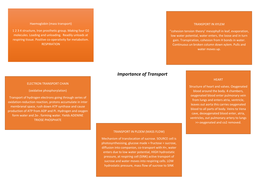Haemoglobin (mass transport) TRANSPORT IN XYLEM
1 2 3 4 structure, Iron prosthetic group. Making four O2 ‘’cohesion tension theory’ mesophyll in leaf, evaporation,
molecules. Loading and unloading. Readily unloads at low water potential, water enters, the loose and in turn
respiring tissue. Positive co-operativity for metabolism. gain. Transpiration, cohesion from H bonds in water.
RESPIRATION Continuous un broken column down xylem. Pulls and
water moves up.
Importance of Transport
HEART
ELECTRON TRANSPORT CHAIN
Structure of heart and valves. Oxygenated
(oxidative phosphorylation) blood around the body. 4 chambers,
oxygenated blood enter pulmonary vein
Transport of hydrogen electrons going through series of
from lungs and enters atria, ventricle,
oxidation-reduction reaction, protons accumulate in inter
leaves out aorta this carries oxygenated
membranal space, rush down ATP synthase and cause
blood to all parts of body. Veins to Vena
production of ATP from ADP and Pi. Hydrogen and oxygen
cave, deoxygenated blood enter, atria,
form water and 2e-. forming water. Yields ADENINE
ventricles, out pulmonary artery to lungs
TRIOSE PHOSPHATE
>> oxygenated and co2 removed.
TRANSPORT IN PLOEM (MASS FLOW)
Mechanism of translocation of sucrose. SOURCE cell is
photosynthesising, glucose made + fructose = sucrose,
diffusion into companion, co-transport with H+, water
enters due to low water potential, HIGH hydrostatic
pressure, at respiring cell (SINK) active transport of
sucrose and water moves into respiring cells. LOW
hydrostatic pressure, mass flow of sucrose to SINK





